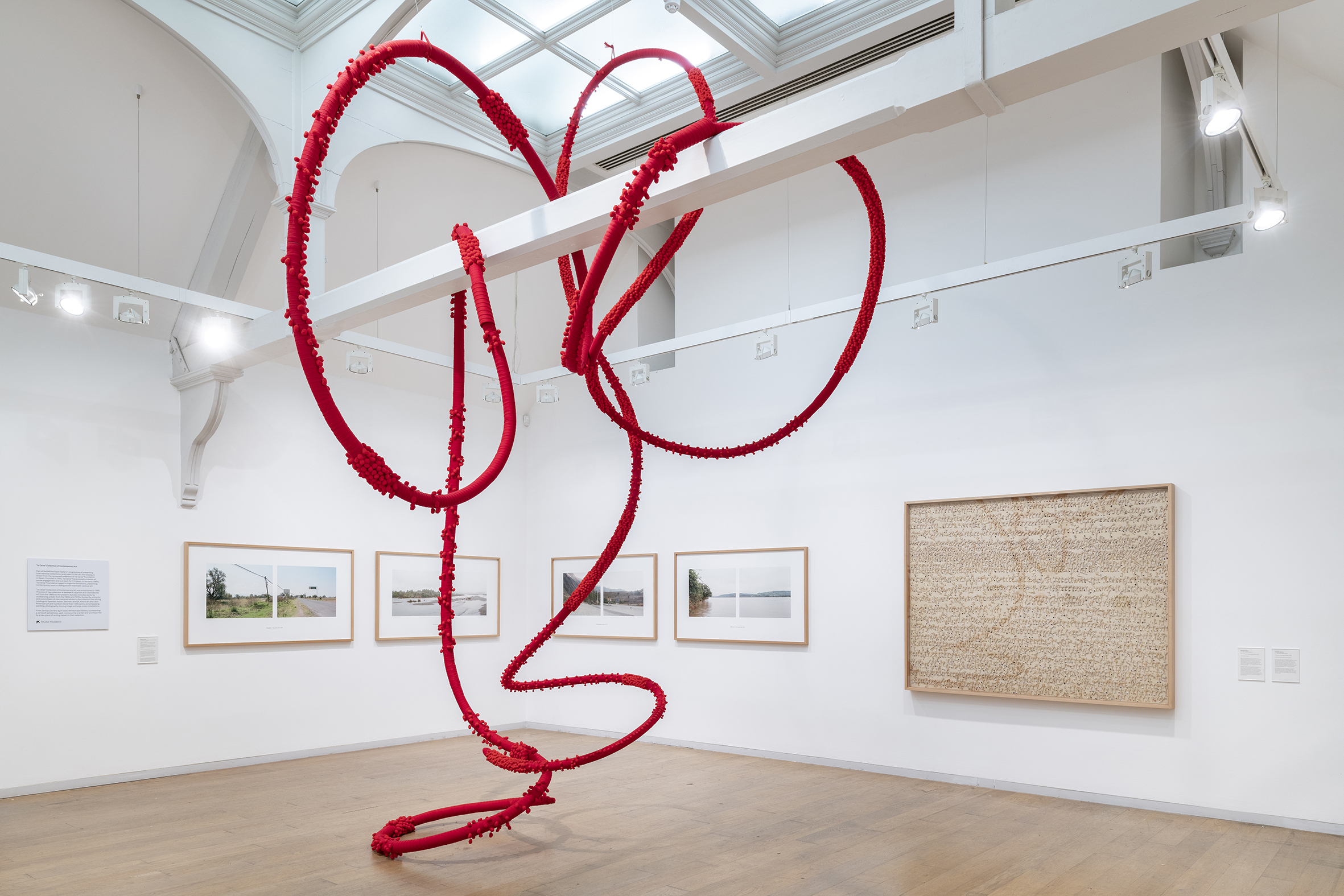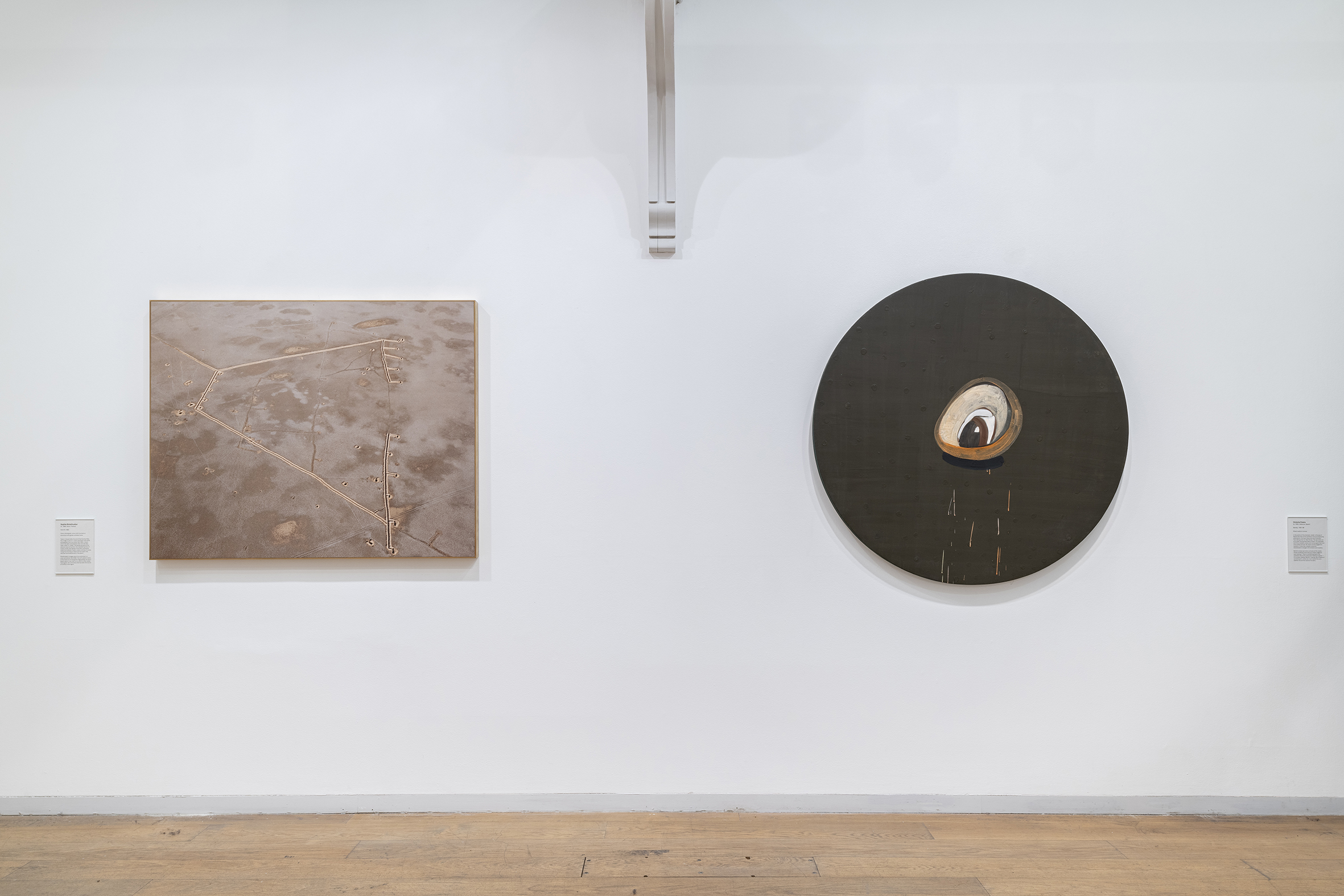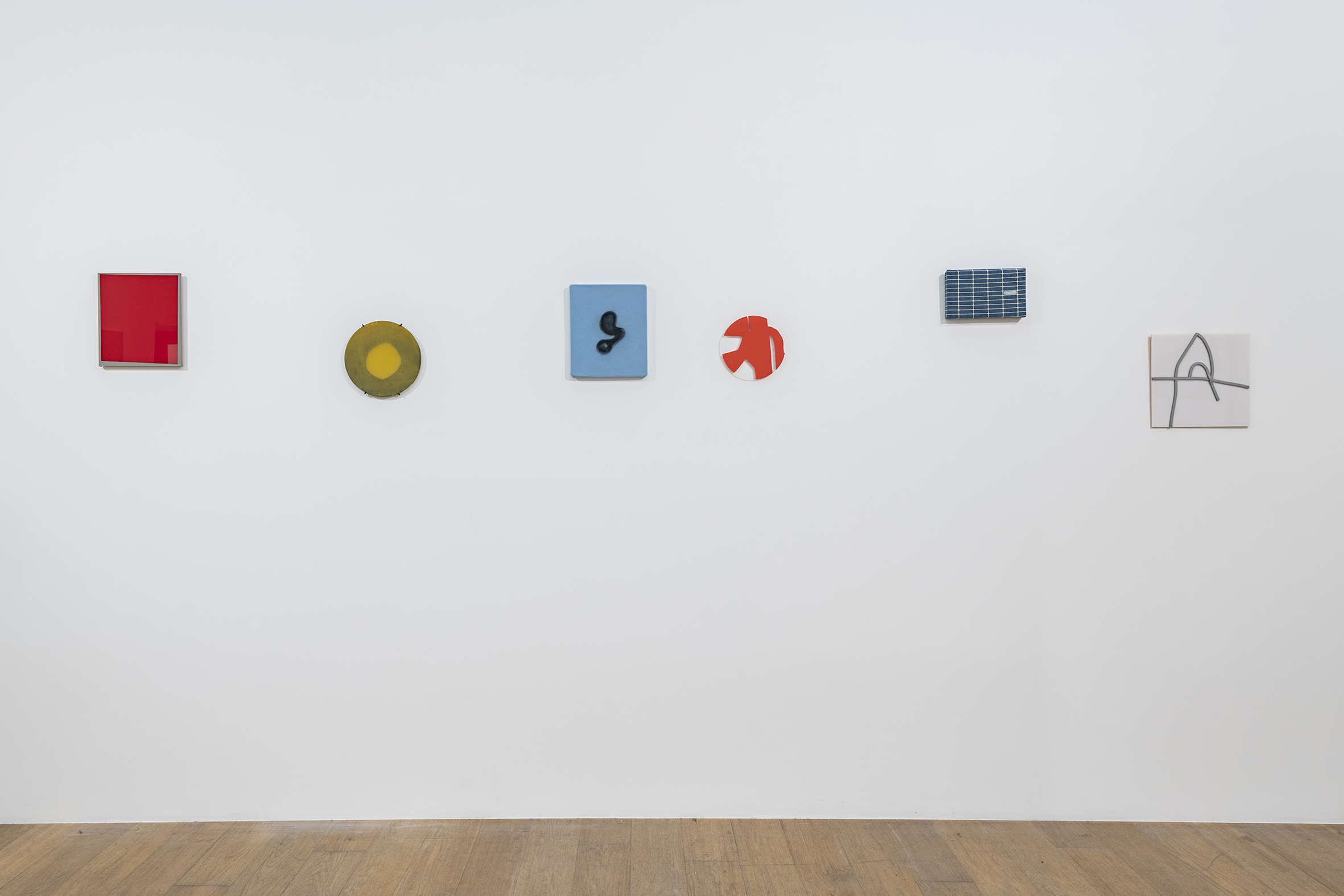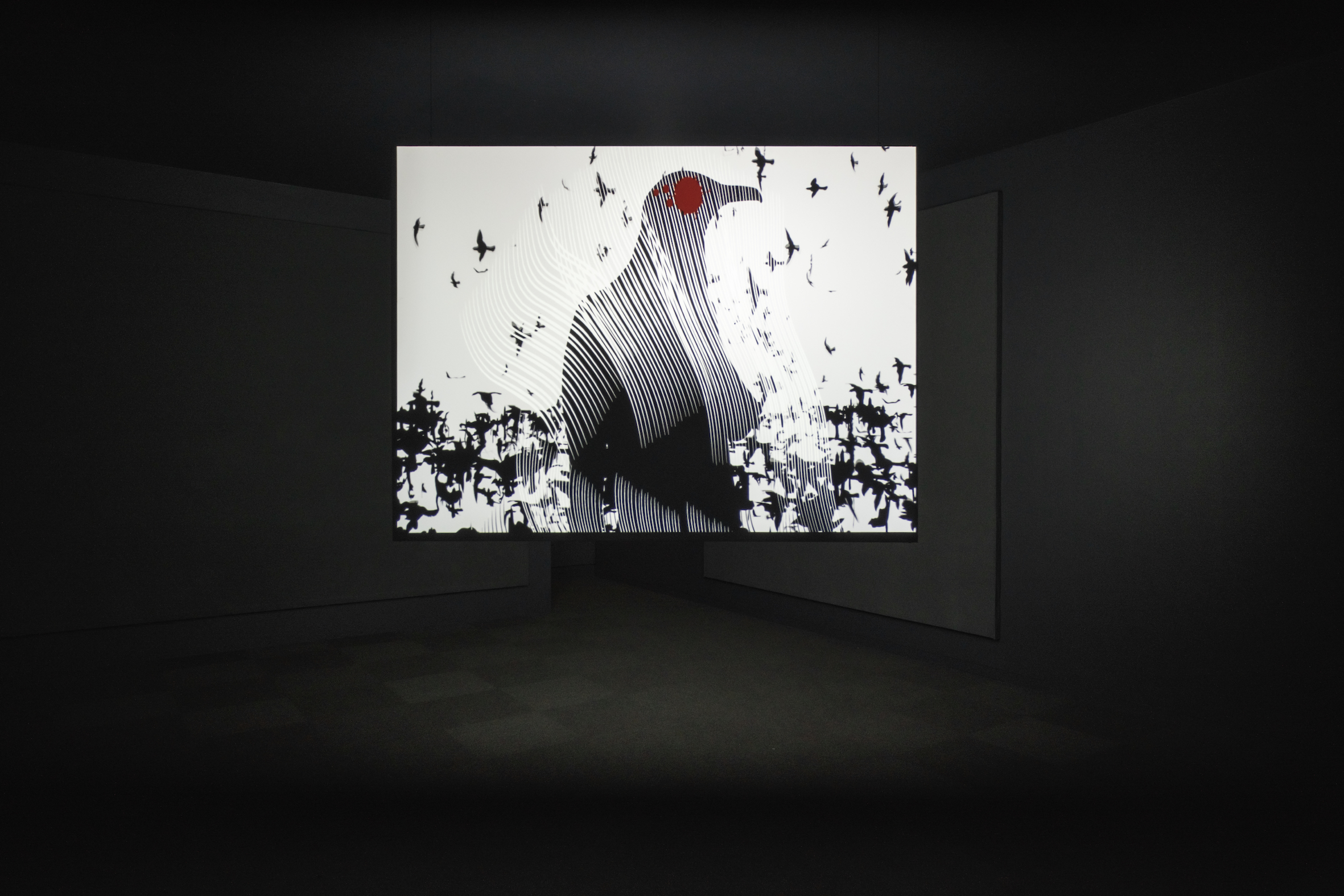Category: Reading List — Published:
From her home in Mexico City, artist and writer Verónica Gerber Bicecci comments on the global pandemic and selects a timely extract from her new book, In the Eye of Bambi, translated by Christina MacSweeney, and published to coincide with Whitechapel Gallery’s exhibition of works she selected from ”la Caixa” Collection of Contemporary Art in Barcelona.
 Portrait of Verónica Gerber Bicecci. Photo: Enrique Ortíz.
Portrait of Verónica Gerber Bicecci. Photo: Enrique Ortíz.
A virus can cause disease, but it is also a tiny agent in charge of exchanging genetic material for the equilibrium of biodiversity. A few months ago, in October 2019 during the inspiring protests in Chile against Piñera’s administration, a projection appeared on a wall of a building in Santiago, saying: “We won’t go back to normality because normality was the problem”. Understanding what we’re facing today, some have said and I agree, goes beyond the virus. The problem is our normality, our toxic craving for what we call normality. We can’t go back there, please! We need to imagine another way of making worlds, as Donna Haraway would say. We need to relate with every life form in some kind of mutualism (if we want to stay on this planet), as anthropologist Anna Tsing would say. I used the phrase that illuminated Santiago nights in my curatorial short story In the Eye of Bambi, written in autumn 2019, in which I try to imagine life after a language disaster through the amazing works of six contemporary visual artists: Victoria Civera, Concha García, Carmen Calvo, Bleda y Rosa, Sophie Ristelhueber and Carlos Amorales.
Un virus puede causarnos enfermedad, pero es también un diminuto agente a cargo de intercambiar material genético para el equilibrio de la biodiversidad. Hace algunos meses, en octubre de 2019, durante las inspiradoras protestas en Chile contra la administración de Piñera, una proyección apareció en el muro de un edificio en Santiago. Decía: “No volveremos a la normalidad porque la normalidad era el problema”. Entender lo que enfrentamos hoy, han dicho algunos y estoy de acuerdo, va más allá del virus. El problema es, en todo caso, nuestra normalidad, nuestro tóxico anhelo de eso que hemos llamado normalidad. Pero no podemos volver ahí, ¡por favor! Necesitamos imaginar otras maneras de hacer mundos, como diría Donna Haraway. Necesitamos relacionarnos con cada forma de vida en algún tipo de mutualismo (si acaso queremos seguir cohabitando este planeta), como diría la antropóloga Anna Tsing. Usé esa misma frase que iluminó las noches de Santiago en mi cuento curatorial En el ojo de Bambi (escrito en el otoño de 2019) donde intento –a través de la obra de seis fantásticos artistas visuales contemporáneos: Victoria Civera, Concha García, Carmen Calvo, Bleda y Rosa, Sophie Ristelhueber y Carlos Amorales – imaginar la vida después de un desastre lingüístico.
 Installation view from In the Eye of Bambi: ”la Caixa” Collection of Contemporary Art, Selected by Verónica Gerber Bicecci at Whitechapel Gallery. Photo: Damian Griffiths.
Installation view from In the Eye of Bambi: ”la Caixa” Collection of Contemporary Art, Selected by Verónica Gerber Bicecci at Whitechapel Gallery. Photo: Damian Griffiths.
This is the tale of the events and images generated (see Episode No. 1: Afterwards) by the creatures with three hands (also known as Homo sapiens) (see Episode No. 2: Before); the glimmers of what was once thought to be the duration of things. These are the fools who haunt the tentacular ongoing destruction, the scars on the fibrous, lumpy now (see Episode No. 3: Now). These are, these were, these will be the splintered echoes of their voices.
Episode No. 1: Afterwards
Things aren’t in their proper place now.
The sun had driven even the tiniest cloudlet from the sky. The air quivered in glassy, transparent ripples as it does over a flame. With so much calm, it seemed that the earth would split in half. And it did. First the crust; there was a sound like a shock wave. The air was throbbing with repeated thunderclaps. The seas and waters blotted out out shorelines and seeped into frontiers. What remained were strata and nuclei. Lightning flashed in the clear sky, and the thunder growled. One by one, the tectonic plates shifted and broke up. What had once been countries glided apart, slightly frightened; islands of clay drifting with the freedom of flotation in a thick fluid that was no longer exactly water. NewNations with rotation and orbits formed; gelatinous entities that before had been federal. The terrain mutated into a colloidal state with the gravitational interaction of a crystal ball. Pendulous, changeful, the world map disintegrated and reformed without violence. The planet became a souvenir of itself: a snow globe in which, instead of ice crystals, the regions and landscapes swam in circles.
The inhabitants of the new oscillating surfaces lost their heads. They charged at each other. All sorts of creatures were swarming past, scampering blindly over one another. Species, macro- and microspecies in altered states of matter: scrap metal and vertebrates, synthetic elements and invertebrates. Finches warbled, the little red-throat and the gold finch were heard. The ruins of everything that had existed Before fused in organo-inorganic symbiosis. The doves rushed from place to place with a loud clapping and rustling of wings. The pheasants cackled as though their throats would burst. The noise they made as they flew from their roosts to the round, was subtle but powerful. Suddenly, a seagull flew back on itself. It twisted into a tiny pixel. Or a scrap of paper. It was bleeding light from the corners of its eyes and kept uttering a metallic, splintering call with its soft ensuing chuckle. Its body was transfigured, affected by a problem in the backlight. Or the coding. Or DNA. It moulted into another body: showers of feathers fluttering.
The north wind raged through the foliage all day and all night long. It seemed to be driven by some incomprehensible ice-cold fury that impelled substances and organs to madness, as though it wanted to tear up its roots, destroy, annihilate itself. Night was no longer black, vertical filters were polarising the light while horizontal ones allowed a degree of luminescence to pass. A secondary, vaguely silvery grey spread through the skies of the NewNations, covering the forest like a dawn. A rain of liquid crystals fell in raging torrents, penetrating even the thickest parts of the undergrowth. The grey was inspired by the black soil spectrum, charred wood and concrete. The birds continued to mutate in the dusty light. Eventually, they demolecularised and formed permeable entities: filters made of skin or of bubbles. The humans attempted to survive by going undercover as other creatures (penguins, eagles or monkeys). But their pale bodies and their faces, entirely bare around the nose and the eyes, gave them away. At the very end, they regressed to crawling on all fours and grew monkeys’ tails. The monkeys, for their part, protected their heads with the crania of human primates. Cobwebs clung to the wind, tangling in it, but the creatures who lived in them fell into the void. The trees wailed in stubborn resistance to the fierce onslaught. Their long-drawn moans, were audible, the loud snap when their strong limbs split, the angry cracking of their trunks parting.
The secondary grey backdrop became a mesh of low intensity rays in which all bodies and objects, without exception, continued the transposition, bringing together what had seemed until then separate, and separating what had been, until then, together. The thunder cracked five or six times more and various seagulls dropped lifeless to the ground. The rain and wind provoked reflection and refraction phenomena. Sound, light and electromagnetic waves merged. The air was filled with gasps, sobs. The she-humans forgot how to control their bodily natures and walked among the fallen seagulls towards the angle of inclination of the parallax. Nothing else could be heard, besides the echo of phenols and dioxins that swooped down with brutal force on the bodies and drowned all lesser noises. The flat land was covered by fragments, remains and vestiges of a relatively recent history. The last shehuman dropped onto all fours; and as she fell her naked skin sprouted feathers, hair and wings. The last seagulls in the world also plummeted to the ground, and with them everything else. Their fractured bodies floated in the metabolism of the NewNations. Only echoes remained. That was the world Afterwards.
 Installation view from In the Eye of Bambi: ”la Caixa” Collection of Contemporary Art, Selected by Verónica Gerber Bicecci at Whitechapel Gallery. Photo: Damian Griffiths.
Installation view from In the Eye of Bambi: ”la Caixa” Collection of Contemporary Art, Selected by Verónica Gerber Bicecci at Whitechapel Gallery. Photo: Damian Griffiths.
Este es el recuento de los sucesos e imágenes que desencadenaron (ver Episodio n.º1: Después) las criaturas necias de tres manos (también conocidas como Homo sapiens) (ver Episodio n.º2: Antes); los destellos de aquello que alguna vez se consideró la duración de las cosas. Estos son los fantasmas de la destrucción tentacular continua, las cicatrices grabadas en el espeso, fibroso y grumoso ahora (ver Episodio n.º3: Ahora). Estos son, estos eran, estos serán los ecos escindidos de sus voces.
Episodio n.º1: Después
Las cosas ya no están en su lugar.
El astro rey había hecho desaparecer hasta la más pequeña nube del cielo. El aire se estremecía en ondas brillantes, transparentes, como las que se observan en la part e superior de una llama. Toda esa calma hacía pensar que la Tierra podía partirse en dos. Y así fue. Primero la corteza: se oyó un sonido parecido al de una onda de choque. El aire vibró por efecto del estruendo. Los mares y las aguas emborronaron las orillas y humedecieron las fronteras. Después se quebraron los mantos y núcleos. Relumbró el relámpago en el cielo despejado y el trueno retumbó. Las placas tectónicas se fracturaron una a una. Lo que alguna vez fueron países bucearon disgregados en un manso espanto; islas de arcilla a la deriva, con libertad de flotación en un fluido denso, que ya no era exactamente agua. Se formaron NuevasNaciones con rotación y traslación; entidades gelatinosas que antes fueron federativas. El territorio mutó a un estado coloidal con la interacción gravitatoria de una bola mágica. Pendular y vacilante, el mapamundi se desintegraba y recomponía, sin violencia. El planeta quedó convertido en su propio souvenir: una bola de cristal en la que, en lugar de nieve, nadaban en círculos todas las regiones y parajes.
Los sobreviventes de las nuevas superficies oscilantes perdieron la cabeza. Corrían los unos hacia los otros, embistiéndose. Toda suerte de criaturas pasaba sin cesar, atropellándose, chocando ciegamente. Especies macroscópicas y microscópicas en estados alterados de agregación de la materia: chatarra y vertebrados, elementos sintéticos e invertebrados. Los pinzones trinaban, el diminuto petirrojo y el pintacilgo también s e dejaban oír. Las ruinas de lo que había sido Antes se fundieron en una simbiosis organoinorgánica. Las palomas iban alborotadamente de un lado para el otro, haciendo mucho ruido con su batir de alas. Los faisanes cacareaban de una manera que parecía que la garanta les iba a estallar. El rumor que producían al volar de la ramazón de los árboles al suelo era sutil y a la vez potente. De pronto, una gaviota voló contra sí misma. Se torció y se deformó convertida en un trozo de pixel. O de papel. Sangraba luz en el contorno de sus ojos. No dejaba un instante de emitir su llamada metálica y quebradiza, seguida de un cloqueo muy suave. Su cuerpo se transfiguró, afectado por un problema de trasluz. O de código. O de ADN. Mudó en otro cuerpo: lluvia de plumas, aleteos desesperados.
El viento del norte soplaba a través del follaje durante todo el día y toda la noche. Parecía impelido por una incomprensible y fría rabia que guiaba a las sustancias y órganos hasta el extremo de la locura; daba la impresión de que quería desarraigarse, devastarse, aniquilarse. La noche dejó de ser oscura, tenía filtros verticales polarizando la luz y otros horizontales permitiendo cierta luminiscencia. Un gris secundario, ligeramente platinado, se propagó en el firmamento de las NuevasNaciones, cubrió el bosque como aurora. Caía a torrentes una lluvia de cristales líquidos. Penetraba hasta en las partes más tupidas de la espesura. El gris estaba inspirado en el espectro de la arcilla negra, la madera carbonizada y el concreto. Las aves siguieron mutando en la luz polvosa. Eventualmente, se desmolecularizaron y formaron entidades permeables: filtros de piel o filtros burbuja. Los humanos se disfrazaron (de pingüinos, de águilas o de monos) para sobrevivir encubiertos de otras especies. Pero sus cuerpos y rostros pálidos, sin pelos alrededor de la nariz y de los ojos los delataron. En los últimos minutos volvieron a gatear y les crecieron colas de mono. Los monos, a su vez, se protegieron la cabeza con cráneos de primates humanos. Las telarañas se aferraron al viento, se enredaron en él, pero sus habitantes cayeron al vacío. Los árboles empezaron a gemir en voz alta y ofrecían obstinada resistencia a la fiera embestida. Podían oírse sus hondos chasquidos, el estallar de sus ramas al quebrarse, el colérico crujir de los troncos al romperse.
El fondo gris secundario se estableció como una malla de rayos de baja intensidad, en la que los cuerpos y objetos, sin diferencia, continuaron la transposición; juntando lo que, hasta entonces, parecía haber estado separado, y separando lo que, hasta entonces, había estado junto. El trueno volvió a dejarse oír cinco o seis veces más, y varias de las gaviotas que emprendieron vuelo, cayeron sin vida. La lluvia y el viento revolvieron los fenómenos de reflexión y refracción. Las ondas sonoras, lumínicas y electromagnéticas se confundieron. El aire se llenó de voces entrecortadas. Las humanas olvidaron cómo controlar la naturaleza de sus cuerpos y caminaron, entre las gaviotas caídas, hacia el ángulo de paralaje. Nada más podía oírse fuera del eco de fenoles y dioxinas que se ensañaba con una fuerza brutal en los cuerpos y apagaba los ruidos menores. La llanura se pobló de fragmentos, de restos y vestigios de una historia relativamente cercana. La última humana se derrumbó contra sí misma; al caer, su piel desnuda se cubrió de plumas y pelos y alas. Se desplomaron también las últimas gaviotas del mundo, y con ellas, lo demás. Sus cuerpos desglosados flotando en el metabolismo de las NuevasNaciones. Solo quedaron los ecos. Así era el mundo Después.
 Installation view from In the Eye of Bambi: ”la Caixa” Collection of Contemporary Art, Selected by Verónica Gerber Bicecci at Whitechapel Gallery. Photo: Damian Griffiths.
Installation view from In the Eye of Bambi: ”la Caixa” Collection of Contemporary Art, Selected by Verónica Gerber Bicecci at Whitechapel Gallery. Photo: Damian Griffiths.
Verónica Gerber Bicecci is a visual artist who writes. She is the author of Mudanza (Mexico City: Ed. Auieo–Taller Ditoria, 2010), Empty Set (Minneapolis: Coffee House Press, 2018, translated by Christina MacSweeney), which won the 3rd International Aura Estrada Literature prize and Otra Mirada Cálamo prize and Migrant Words (Guadalajara: Impronta Casa Editora, 2019, translated by Christina MacSweeney). Her most recent projects in other media are: vocabulary b (2019) in muca Roma, Mexico City and The Dystopian Machine [www.lamaquinadistopica.xyz] (2018) in the Museo de Arte Abstracto Manuel Felguérez, Zacatecas. She was an editor at the Mexican publishing cooperative Tumbona Ediciones (2010–2017) and tutor of the Photography Production Seminar (2016–2018) at Centro de la Imagen.
Christina MacSweeney was awarded the 2016 Valle Inclán Translation Prize for Valeria Luiselli’s The Story of My Teeth (add city, publisher, date) and her translations of other works by Latin American and Spanish authors, including Verónica Gerber Bicecci’s Empty Set, have received critical acclaim. She has also contributed to a number of anthologies of Latin American writing.
 Installation view from In the Eye of Bambi: ”la Caixa” Collection of Contemporary Art, Selected by Verónica Gerber Bicecci at Whitechapel Gallery. Photo: Damian Griffiths.
Installation view from In the Eye of Bambi: ”la Caixa” Collection of Contemporary Art, Selected by Verónica Gerber Bicecci at Whitechapel Gallery. Photo: Damian Griffiths.
Note: The majority of the phrases in italics are from Bambi, a Life in the Woods by Felix Salten, first published as Bambi: Eine Lebensgeschichte aus dem Walde in 1923. All others are from: the Comex Color Life Trends 2020 catalogue (various authors); a number of common slogans and catchphrases of the top 100 companies that are destroying the planet featured at decolonialatlas.wordpress.com; some Wikipedia data and paraphrases of various online news items; a few words from Manifestly Haraway by Donna Haraway (2016); Greta Thunberg’s “Our house is on fire” speech (The Guardian, 25/01/2019) and W. B. Yeats’ “The Second Coming” (1919).